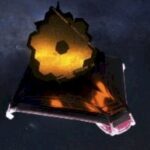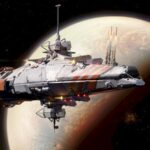
NASA is scheduled to share the primary full-color photos from the James Webb Space Telescope (JWST) in lower than every week. Ahead of that launch, the workforce captured a reasonably spectacular picture of deep area with one in every of its devices whose main function, by the way, isn’t truly taking photos.
The world awaits July 12, 2022, when NASA will lastly share the primary full-color photos from JWST. The journey has been an extended one, with the spacecraft having travelled practically a million miles from Earth. The journey has not been all clean crusing, as a micrometeoroid slammed into one of many telescope’s main mirror segments someday between May 23 and 25, 2022. NASA stated to not fear, nevertheless, that the $10 billion area telescope could be simply positive. Now the area company has launched a picture taken by its Fine Guidance Sensor (FGS) that exhibits a little bit of JWST’s potential forward of subsequent week.
While FGS is able to capturing imagery, its main function is to allow correct science measurements and imaging with precision pointing. When it does take an image, these photos are usually discarded. This is principally as a consequence of the truth that the communications bandwidth between L2 and Earth is restricted, and Webb sometimes solely sends knowledge from as much as two science devices at a time. But throughout a week-long stability check again in May, the workforce determined they may maintain the imagery from FGS as a result of there was out there bandwidth.
The workforce admits that the engineering check picture has some “rough-around-the-edges” qualities to it, because it was not optimized to be a science statement. Even so, to the untrained eye the picture is sort of spectacular. The picture does have a number of the hallmarks of different check photos taken for the reason that launch of JWST. Brighter stars are seen with their trademark six, lengthy, sharply outlined diffraction spikes, an impact that happens as a consequence of Webb’s six-sided mirror segments. Dimmer stars and galaxies fill out the remainder of the background.
The ensuing picture was captured utilizing 72 exposures over a 32 hour interval, and is likely one of the deepest photos ever taken of the universe, based on Webb scientists. One of the explanations FGS isn’t used as a main digicam, is because of the truth that when its aperture is open, it doesn’t make the most of coloration filters like the opposite science devices. This makes it inconceivable for scientists to review the age of the galaxies captured inside a picture with the usual wanted for scientific evaluation.
“With the Webb telescope achieving better-than-expected image quality, early in commissioning we intentionally defocused the guiders by a small amount to help ensure they met their performance requirements. When this image was taken, I was thrilled to clearly see all the detailed structure in these faint galaxies. Given what we now know is possible with deep broad-band guider images, perhaps such images, taken in parallel with other observations where feasible, could prove scientifically useful in the future,” remarked Neil Rowlands, program scientist for Webb’s Fine Guidance Sensor, at Honeywell Aerospace.
The check picture ought to give all awaiting the primary full-color photos subsequent week much more motive to be excited. JWST presents a possibility to discover deep area in methods by no means attainable earlier than. Because of this, astronomers and scientists are hoping to have the ability to reply lengthy held questions concerning the universe. “The faintest blobs in this image are exactly the types of faint galaxies that Webb will study in its first year of science operations,” said Jane Rigby, Webb’s operations scientist at NASA’s Goddard Space Flight Center in Greenbelt, Maryland.
Top Image Credit: NASA









![[Deep breath] Tom Clancy's The Division 2 Warlords of New York Growth Yr 5 Season 1 Damaged Wings Descent Mode shall be on public check servers tomorrow [Deep breath] Tom Clancy's The Division 2 Warlords of New York Growth Yr 5 Season 1 Damaged Wings Descent Mode shall be on public check servers tomorrow](https://gamecravings.com/wp-content/uploads/2023/04/83955/deep-breath-tom-clancys-the-division-2-warlords-of-new-york-growth-yr-5-season-1-damaged-wings-descent-mode-shall-be-on-public-check-servers-tomorrow-150x150.jpg)